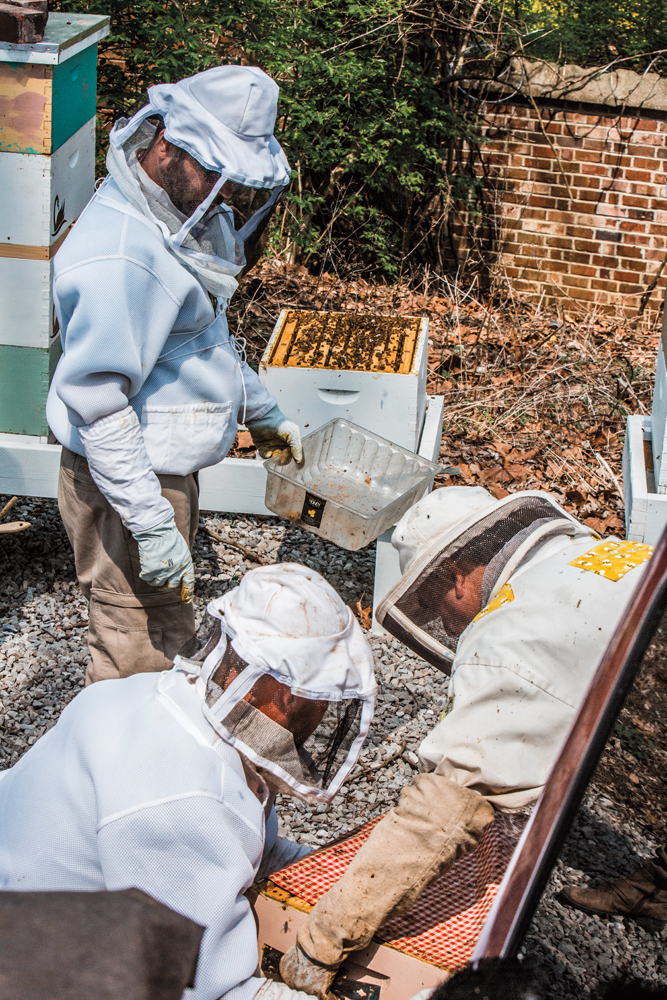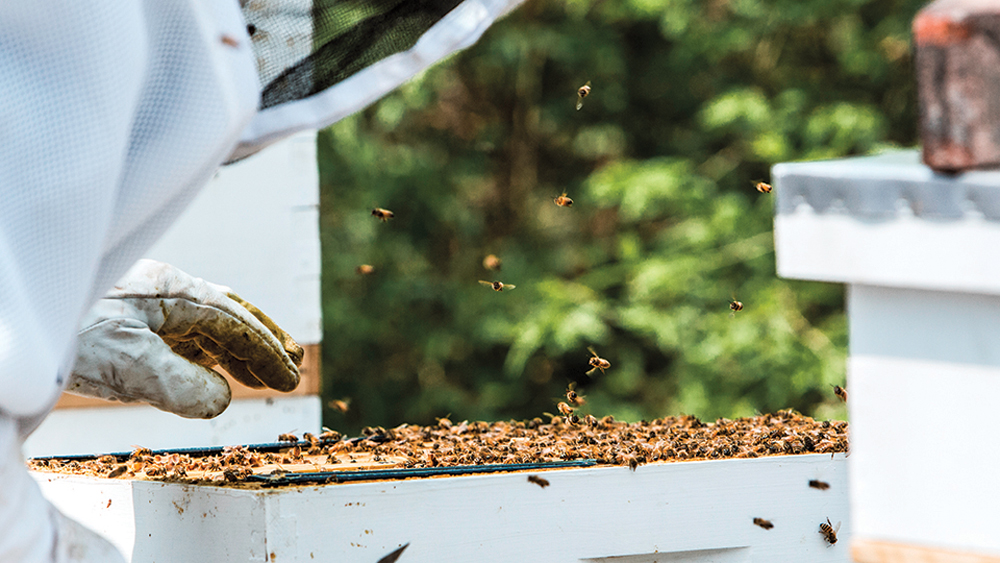We’re going to see swarms today, no question about it. The conditions are ripe: It’s mid-April and sunlight washes through the trees of Cave Hill Cemetery in a green mist, maintaining a steady 73 degrees. Rodolfo Bernal walks around his maroon Ford pickup, which sports an old Obama bumper sticker and another that says “Topless Mountains Are Obscene,” and stands close, within three inches of my person, like he’s about to share a secret. There’s no time to waste on small talk. “I’m trying to get Cave Hill to understand the whole cycle of beekeeping,” he says. He guides me toward a tree and points upward at a box, wooden by the look of it, strapped to a branch maybe 10 or 15 feet in the air. “This is a swarm box,” he says. Around this time of year, bees fill their hives with so much honey they crowd themselves out, and a process called swarming begins. The queen leads part of the hive out on a colonial conquest for a new home, leaving behind a new ruler. “And in the city, they will look either for trees that have a cavity, or they will look for a building to go in,” Bernal says. “That’s where problems happen for people.”
 |
His swarm box, one of several he has rigged up around Cave Hill, is meant to prevent that. He says he once kept a swarm box near the grave of Muhammad Ali, which seemed entirely appropriate to him, though the cemetery did not quite agree that the metaphor trumped the safety of visitors, and asked him to catch bees elsewhere. “And I don’t understand why,” he says. “One day I met Lonnie Ali. My swarm box was right there, and I asked her, ‘Do you mind?’ She loved it.”
He’s had plenty of success since he first brought about four of his own beehives to the cemetery several years ago, lured by its ecological potential. The 296-acre cemetery’s abundance of flowers and plant life, proximity to Beargrass Creek, and five lakes make it a honeybee utopia. “It was a rich environment that really had been untapped,” says Michael Higgs, recording secretary for Cave Hill and manager of the Cave Hill Foundation.
“My bees have done well here,” Bernal confirms. His collection has grown to 13 hives, and he says they are far more productive than the hives at his rural home in Oldham County. Higgs says that, last year, Cave Hill sold about 1,500 to 2,000 jars of honey, harvested and bottled privately by Bernal and then sold back to the cemetery. An eight-ounce jar costs $10, and 16-ouncers go for $13.
Bernal encouraged the cemetery to develop a beekeeping team of its own, led by head apiarist Roger Martin. Cave Hill now manages eight hives separately from Bernal’s, and though they are not yet producing honey, Higgs expects bounties in the seasons to come, and Cave Hill is setting up a honey house in a small building near the entrance to the cemetery, where workers will process and bottle honey on their own.
A short drive down a winding, narrow road leads us into an old part of the cemetery, where many of the graves have worn down into lichen-blotched illegibility; the death dates remaining visible list years in the late 1800s. Bernal’s 13 hives stand in a row before a high brick wall, each a stack of pastel-colored boxes, some only one box high, one a towering six. The different colors help bees differentiate between hives, Bernal says. When I ask about the monkeys he’s painted on the sides, their tales swirling like hypnotists’ pendulums, he says, simply, “I’m from Peru.” A thick glob of bees writhes across the exterior of one hive, and an angry buzzing cloud envelops the area, rippling and tumbling in dazzling murmurations. Bernal tells me the bees aren’t dangerous when they swarm, but I let him help me into a screened hat before he pulls on a beekeeping jacket with a Kentucky Beekeepers Association patch on the bicep. He doesn’t put on his gloves until he’s already surrounded by bees, which don’t faze him in the slightest.

Sure enough, a hive is swarming. Bernal fills a little silver can with paper and stokes a fire inside, pressing bellows to puff smoke at the hive; this prompts angry buzzing, and sends the bees back inside, a bit confused. To prevent part of the colony from taking up residence in a neighbor’s chimney, he splits the hive in two, rearranging boxes and the slats of honeycomb inside. Over the course of about three hours, he trudges through the flying hordes, lifting boxes heavy with honey, prying them open with metal tools, lifting out slats and holding them up like surgeons do with X-rays, watching for capped cells of honey, or larvae, or parasites, which are thankfully absent. He splits two hives, upping his total to 15.
Bernal waves me into the bees, and I tiptoe in. They crawl through my hair and seem to sniff at my bare arms. He points at a big drop of glistening honey on top of a hive. “Taste it,” he says. A bee standing on the hive has a staring contest with my finger, but decides I’m not worth the effort, and lets me have my way. I have never tasted honey so sweet and rich with pollen. It’s almost worth the risk.
Bernal, who turns 67 this month, spends anywhere from 30 minutes to five hours working with the hives, which he visits multiple times each week. By the time he finishes, he’s wet with sweat. I can’t help but wonder if the honey itself is what gives him the energy to keep up with babysitting thousands of stinging wards, which, yes, of course, have let him have it plenty of times. Each morning, after he wakes up around 5 a.m., he has a spoonful of a tonic he makes with the honey, coconut oil, turmeric, ginger, peppers and ashwagandha. “Delicious, man,” he says. “Delicious.”
This originally appeared in the June 2019 issue of Louisville Magazine under the headline "The Hives of Cave Hill." To subscribe to Louisville Magazine, click here. To find us on newsstands, click here.
Photos by Mickie Winters, mickiewinters.com



